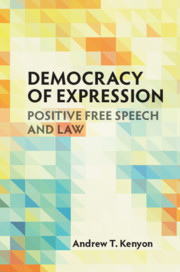Book contents
- Democracy of Expression
- Democracy of Expression
- Copyright page
- Contents
- Preface
- 1 Introduction
- 2 Positive Free Speech from Media Studies and Law
- 3 Positive Free Speech and Democracy
- 4 Positive Human Rights and Political Freedom
- 5 US Legal Writing on Positive Free Speech
- 6 German Broadcasting Freedom
- 7 French Freedom of Communication and Pluralism
- 8 Framing Communicative Freedom
- Bibliography
- Index
8 - Framing Communicative Freedom
Published online by Cambridge University Press: 28 May 2021
- Democracy of Expression
- Democracy of Expression
- Copyright page
- Contents
- Preface
- 1 Introduction
- 2 Positive Free Speech from Media Studies and Law
- 3 Positive Free Speech and Democracy
- 4 Positive Human Rights and Political Freedom
- 5 US Legal Writing on Positive Free Speech
- 6 German Broadcasting Freedom
- 7 French Freedom of Communication and Pluralism
- 8 Framing Communicative Freedom
- Bibliography
- Index
Summary
‘Positive’ in positive free speech can mean enabled freedom or a legally (and perhaps judicially) protected right. Both meanings can be important. Understanding arguments for positive free speech and how some courts protect it reveals what the freedom entails, provides ideas and techniques for various constitutional actors, and suggests the improbability of legislatures alone protecting positive free speech enough. A partial framework for the positive freedom is taken from earlier chapters, drawing on media studies models of diverse media, the freedom’s democratic basis, analyses of positive human rights, political freedom, the US First Amendment, and constitutional law from Germany and France. Questions about democratic legitimacy and judicial rights protection are examined. Criticisms of judicial rights review can presuppose effective public speech, but such speech appears unlikely without legal protection of positive free speech which may well require judicial action, although questions remain about such action’s effectiveness. Finally, points are raised about applying historical lessons of this study to the changed contemporary environment for public speech.
Keywords
- Type
- Chapter
- Information
- Democracy of ExpressionPositive Free Speech and Law, pp. 209 - 246Publisher: Cambridge University PressPrint publication year: 2021

